Chartres Pilgrimage Offers a Traditional Route to Christ and His Church
The 37th-annual pilgrimage from Our Lady in Paris to Our Lady in Chartres has gathered more than 14,000 people of all ages and from many nations, honoring a 1,000-year tradition.

The Chartres Pilgrimage often receives few headlines in the secular press, but this popular exercise in Catholic devotion has become one of the most attended events in France. Beginning in 1983, each year the pilgrimage, also known as the Pilgrimage of Christendom, has been gathering thousands of people on the Solemnity of Pentecost for a three-day trek from the Cathedral of Notre Dame in Paris to the Cathedral of Notre Dame in Chartres.
This year, because of the fire that ravaged Notre Dame in Paris on April 15, the pilgrims departed instead from the emblematic Church of St. Sulpice in the early morning of Saturday, June 8, after attending the opening Mass. More than 14,000 pilgrims took part this year — with more than 1,300 foreigners coming from 20-plus different countries. Participants undertook the journey equipped with flags and banners and divided into chapters. As in past pilgrimages, this year’s event also included 3,500 non-walking pilgrims, called the “guardian angels,” who were united with the walkers in prayer.
Organized by the Catholic lay nonprofit organization Notre-Dame de Chrétienté (“Our Lady of Christendom”), the pilgrimage was inspired by French-Catholic writer Charles Péguy, who made a solitary pilgrimage from Notre Dame of Paris to the Marian sanctuary of Chartres in 1912, covering more than 86 miles in four days, June 14-17, to ask the intercession of the Virgin Mary to help his ill son. He undertook the same pilgrimage a year later, shortly before losing his life on the battlefield at the beginning of World War I in 1914.
Renewed in the latter part of the 20th century, today’s pilgrimage follows in the footsteps of Péguy but also continues a medieval tradition designed to illustrate the Christian view of a man’s time on earth as a pilgrimage toward eternity.
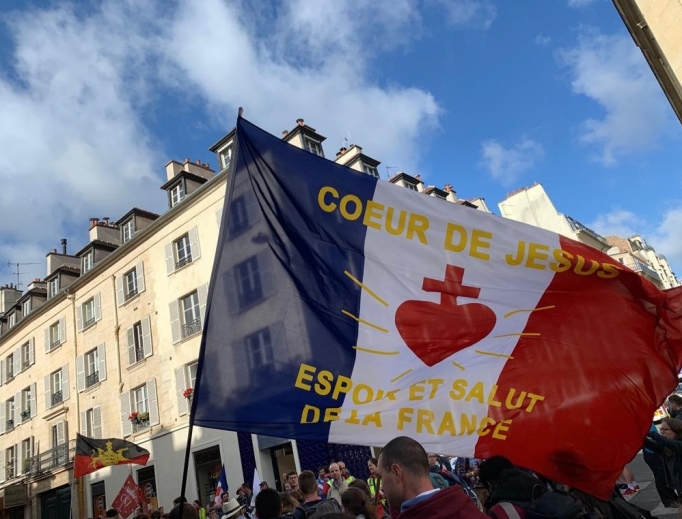
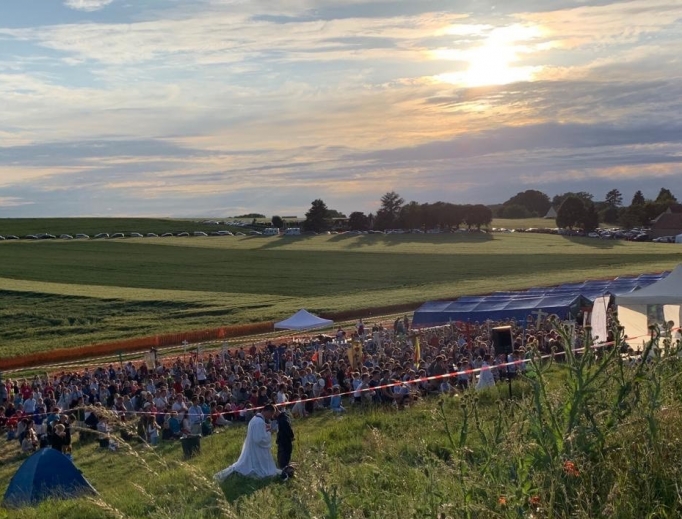
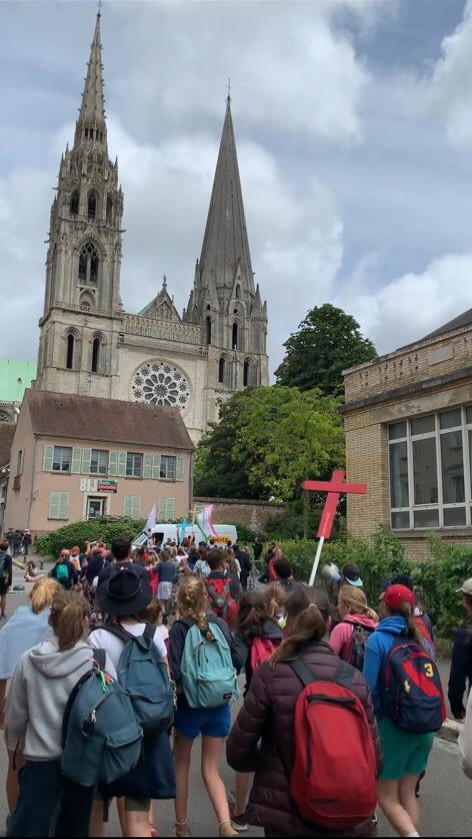
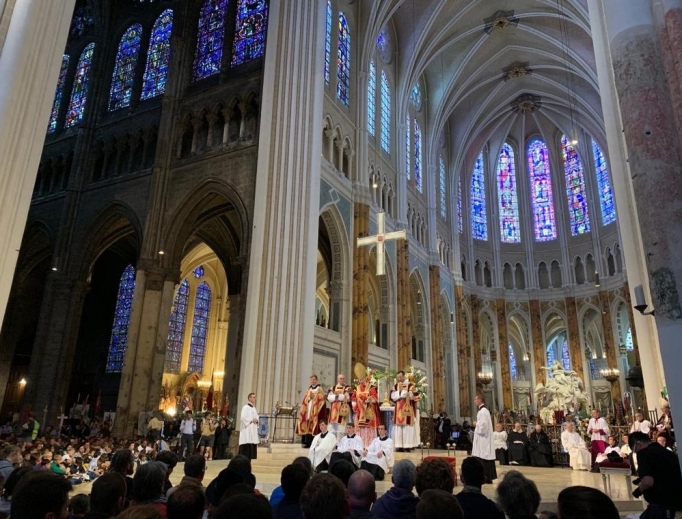
Road to Tradition
“The strength of this pilgrimage is the French-Catholic culture, the fact that we’re participating in a pilgrimage that had begun in medieval times and that we see the monuments of French history, knowing that the saints have walked along in the same paths, in the same way,” said Father Garrick Huang, the spiritual director of the American chapter called Our Lady of the Most Holy Rosary. He added that the faith of France, even though it has become a minority, is still practiced in a very authentic way.
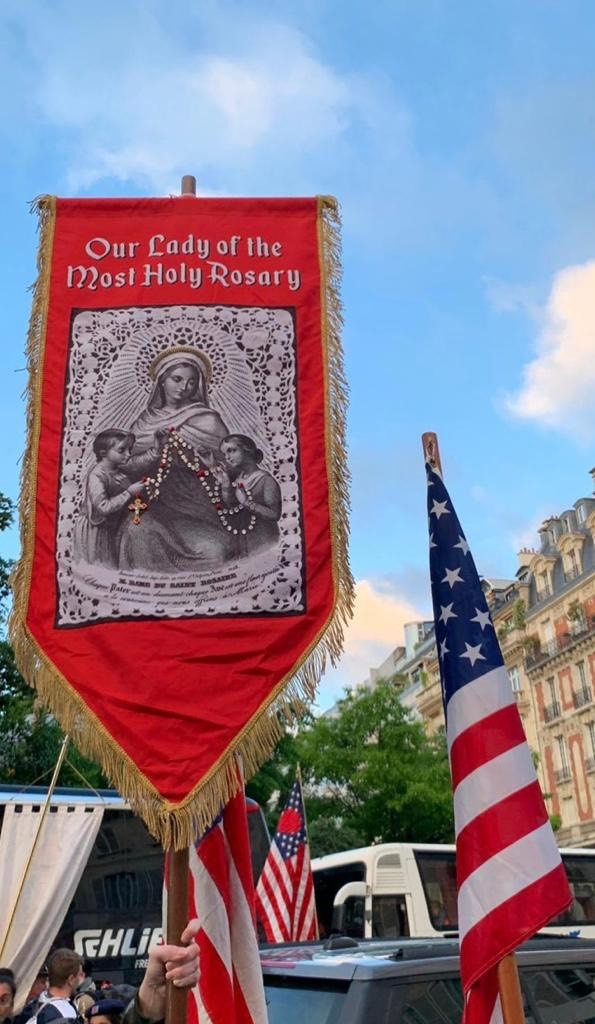
“It gives us hope, and we need this example,” Father Huang told the Register. “Also to see the beauty of what the faith gave to Europe, the beautiful architectures, sculptures, the Gregorian chants we’re singing. It is our heritage, and we can still enjoy this beauty.”
It is the same passion for tradition that has been driving American Catholic lawyer Brad Smith on the road to Chartres almost every year for the past 20 years.
“Tradition is not just about maintaining a certain practice because it has always been done this way,” Smith told the Register. “It is about handing over something which the previous generations defended, fought for and made many sacrifices for, whether it is the poor people who gave donations to build their cathedral, their churches, or the oak confessionals or the paintings, the sacred instruments: All of that is our inheritance.”
According to Smith, defending tradition as every Catholic’s common inheritance offers important spiritual benefits — and an opportunity to lead others to Christ.
“We have a common patrimony and inheritance that it is not for us to squander with bad modern sacred art, for instance,” he said. “It is about defending that which saves souls, that has been proven to be edifying for centuries and passed on to our descendants.”
But in our secularized Western societies, the defense of Christian tradition can often be synonymous with isolation, especially for younger generations.
“Young people in general can be a bit scared to declare themselves openly Christians nowadays, as they fear rejection and derision,” said Archbishop André-Joseph Léonard, the archbishop emeritus of Mechelen-Brussels. The archbishop served as preacher of the concluding Mass of the pilgrimage at the Cathedral of Chartres.
Strength in Unity
While lamenting the great confusion that followed the series of recent scandals that have beset the Church, Archbishop Léonard praised the pilgrimage as a way to help people become stronger in faith and hope. Indeed, the pilgrims understand that, even as a minority in society, their enthusiastic witness makes them part of a strong and very significative minority.
“I want to tell these pilgrims something,” Archbishop Léonard said. “The Catholic Church, no matter what anyone says, remains the most beautiful multinational [institution] in the world — the Church is a multinational of faith, hope and charity,” he said, recalling that the Church as the Bride of Christ remains spotless, despite the presence of sinners within her. “The Church is holy, through everything she receives from the Lord: Her head is the bosom of God; the Holy Spirit is her soul; the Most Blessed Virgin Mary is her heart. To illuminate her way, she has the holy tradition from the apostles and the Holy Scriptures, and at the heart of her life, there is the Most Blessed Sacrament of the Eucharist.”
The unifying power of the Chartres Pilgrimage is, according to Archbishop Léonard, a renewed invitation to follow together the path of the countless saints who made history and to take part in the holiness of the Church, despite our troubles and weaknesses.
To help communicate this invitation to participants, the theme for this year’s pilgrimage, “The Peace of Christ through the Reign of Christ,” focused on the social doctrine of the Church by offering timely avenues for meditations along the pilgrimage route.
“Such a theme leads us to meditate on the fact that our Catholic faith has a social dimension, that it is not just a personal engagement with God, as it is also a societal movement towards everyone else,” Father Huang said.
As the spiritual director of the American chapter of the pilgrimage, Father Huang encouraged the pilgrims to “focus on the necessity to show that we have to collaborate together to get to heaven,” which implies that the Catholics “cannot be excused from life in society, especially political society, and have to publicly show their faith” to help make room for God.
When faith is not popular, Archbishop Léonard said, “those who have a missionary spirit must feel that they are not alone, that there is a whole missionary surge around them.”
The missionary fervor of so many lay pilgrims and priests, he added, can arouse great vocations, as “we can be real Christians only by being missionaries.”
The Power of Testimony
Evangelization, another core goal of the Chartres Pilgrimage, has been made more concrete this year through the creation of a new ad hoc chapter called “The Pilgrims of Emmaus.” Its 30 young members have the mission to talk to onlookers along the pilgrimage route. Indeed, it happens every year that people who are very far from the faith ask to join the pilgrims along the way.
“Two years ago, an atheist woman that was raised by communist parents saw us, and she was moved by the sight of the walking children,” said Hervé Rolland, the vice president of Notre-Dame de Chrétienté. “She followed us and asked to be baptized six months later.”
The decision to create this new well-organized chapter, Rolland told the Register, is a way to encourage frequent and immediate conversions among non-Catholics — particularly Muslims and atheists — deeply struck by the pilgrims’ fervor.
Such a sudden conversion was experienced 28 years ago by Jean-Christophe Pérardel, the current financial director of the Catholic high school Saint-Jean de Passy in Paris. Pérardel used to be a convinced atheist, although he received baptism in his childhood. In 1991, aged 24, he joined the Pilgrimage of Christendom, but only as a way to see if he had the physical stamina to walk the three-day route. However, his life was about to change forever.
“There was this mysterious atmosphere of friendship among us,” Pérardel told the Register. “I could feel that something was happening here.”
On the third day, as Chartres’ famous spire appeared on the horizon, he found himself walking next to the confessor of his chapter, who spontaneously asked him if he wanted to go to confession.
“I said Yes, but without any real conviction,” Pérardel said, “and I told him I had no idea how to proceed.”
The priest told him not to worry and started asking him questions to guide him.
“The reflections I’ve had along the way were starting to bear fruit,” Pérardel recalled. “I was very sincere with him, and I started crying. Thinking about my life and my past, I was full of remorse.”
“The priest was holding my arm, supporting me physically,” he added, “and when he gave me absolution, my heart was changed, and I never doubted again.”
At the end of that pilgrimage 28 years ago, he received first Communion at Chartres during the concluding Mass, and he is now married and the father of four children, striving to transmit the faith to young generations through his school. He attends the pilgrimage every year and served as a cameraman for this year’s concluding Mass.
“Many Catholics are half-hearted nowadays, and this pilgrimage is precisely a weapon against half-heartedness,” he said.
“As Christians, we are called to have our feet on the ground and our head in the sky,” Pérardel said, “and there is no better opportunity for us to do so.”
Solène Tadié is the Register’s Rome-based Europe correspondent.

















